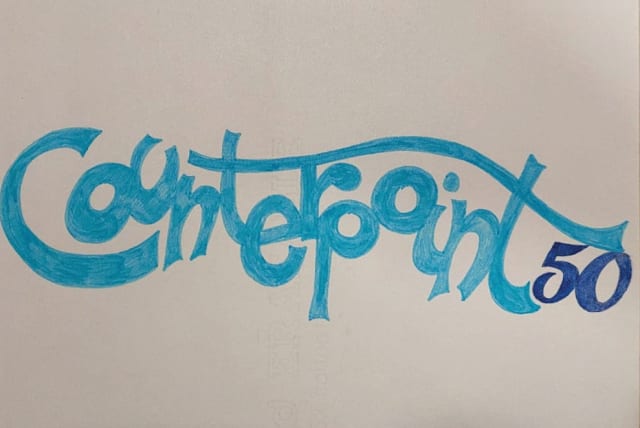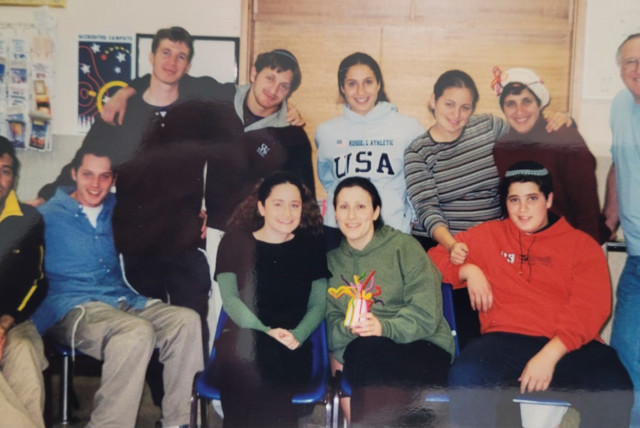Counterpoint turns 50: Celebrating the Jewish education program's success

The story of one of the most successful informal Jewish education programs in the English-speaking world.
Although it happened in the winter of 1974, I can still remember getting that phone call from my friend Rabbi Ephraim Buchwald as if it were yesterday.
I had worked with him the previous summer at the West Coast Torah Leadership Seminar run by Yeshiva University out of New York City. He told me about a new informal Jewish education program being planned for overseas that needed a musician. Effie said I wouldn’t believe where it was taking place: “Australia.” I laughed and answered, “Right!” That was the first time I heard about the Jewish outreach program which was to be called Counterpoint.
To fully understand how this “new” program developed, we have to go back two decades to the early 1950s and the creation of Torah Leadership Seminar (TLS). Run by the Youth Bureau of the Community Service Division of Yeshiva University (YU) under the direction of Abraham Stern, its seminars were attended by Jewish teens who had gone to public schools. Twice a year, during winter vacation and the last week of the summer vacation, these students would attend a week-long learn-a-thon in the US Northeast, the US West Coast, and Central Canada.
The programs featured music, drama, and media plus learning sessions which included much discussion. The participants gained a needed Jewish education while the staff, almost entirely from YU’s undergraduate programs for both men and women, were able to develop their own leadership skills. In 1972, YU launched Yeshiva Seminar, which set out to do for Jewish day school students what Torah Leadership Seminar had done for their co-religionists attending public schools.
A little over a year later, in the summer of 1973 (winter in Australia), Rabbi Norman Lamm, the eventual president of YU, at that time a professor of philosophy, went to Australia, where he lectured in Melbourne and Sydney. His appearances at various Jewish institutions in both cities met with great success. One of the venues where he spoke was Mount Scopus Memorial College in Melbourne – with 2,500 students, one of the largest Jewish day schools in the world at that time.
While Down Under, Rabbi Lamm and his wife, Mindy, were hosted by Hans and Gini Bachrach. Hans, a generous benefactor and Jewish community activist, had bankrolled Lamm’s entire speaking tour. When the Lamms were leaving for home, Mindy turned to her husband and told him what they really needed in Australia was Torah Leadership Seminar. Upon hearing what this revolutionary educational program was all about, Bachrach agreed to sponsor the entire project, including bringing a staff of informal Jewish education professionals from the United States.
With funds not being an issue, Stern flew to Melbourne a few months later to set up the logistics. When he returned to New York, he asked Hillel Davis, a future vice president for University Life at YU, to head the team of 15.
TOGETHER, THEY selected some of the best Torah personalities that Torah Leadership Seminar had produced in the previous decade. Many of them were rabbis who would become religious leaders throughout the English-speaking world. Rabbi Joseph Telushkin was a writer, both fiction and non-fiction, whose biography of the Lubavitcher Rebbe, Rabbi Menachem Mendel Schneerson, would make it to the top of The New York Times’ bestseller list.
Rabbi Saul Berman became the pulpit rabbi at the world-famous Lincoln Square Synagogue in New York and eventually founded Edah, an organization dedicated to the invigoration of Modern Orthodox ideology and religious life. Also on the team was Rabbi Ephraim Buchwald, originally the educational director of Lincoln Square Synagogue and creator of its Beginners’ Service, plus founder of the National Jewish Outreach Program (Shabbat Across America).
Susan (Metzger) Weiss, one of the six women advisers on the team (who eventually moved to Jerusalem), is the founder and executive director of the Center for Women’s Justice in Israel, which works to find solutions for the problems Jewish women encounter regarding divorce.
Our Counterpoint team flew to Australia at the end of June 1974. We first stopped in Los Angeles for a day at Disneyland and to run Shabbat programs at various local synagogues. From there, we flew to Hawaii for a few days of rest and relaxation.
For some of our rabbinical staff, years of religious studies had not been preparation for what to do when greeted at the airport in Honolulu by local women dressed in grass skirts, presenting each of us with individual flower leis. They said “Aloha,” so we answered “Shalom.”
After our arrival in Australia, we headed to Melbourne’s Mount Scopus Memorial College to meet the students. The way we were dressed came as a total surprise to the students. To them, rabbis wore suits and ties and stood on pulpits looking down at their congregants. They had never seen a rabbi in jeans with longish hair sitting on the floor, talking to a circle of students.
This informality was what really attracted them to the staff on the 14-hour train ride from Melbourne to Sydney, where the nine-day seminars were set to take place. There was a five-day event to train local staff for future Counterpoint events and a weekend of Shabbat programs in various Orthodox synagogues in Melbourne. When the Jewish community in Perth heard about what was happening on Australia’s eastern coast, they flew four members of the team out west for a weekend program.
The message that one could now be both cool and religious had spread across the entire country and would leave a mark on the Jewish communities there for years to come.
As our trip neared its end, the Melbourne Jewish community, with the help of Mount Scopus, organized a gala event at a local town hall. Over 1,000 people, both parents and students, came to sing and dance while saying goodbye after a summer/winter that all of us would remember forever.
After seven hard weeks of work, the team was finally heading home. First, there was to be a stop for some well-deserved rest and relaxation – but this time, in New Zealand. Then, before returning to New York, there was one more stop, in Seattle, where YU used the team members one last time to staff their West Coast Torah Leadership Seminar.
What seemed now to be the end of the story turned out to be just the beginning.
Yeshiva University sent Counterpoint teams to Australia for the next 31 years. In 1975, with four members of the previous year’s Australian team, they brought this now world-famous Jewish outreach program to South Africa, where it ran as Counterpoint until 1982.
RABBI SELWYN FRANKLIN, who was part of both teams in Australia and South Africa, soon accepted pulpits in Durban, South Africa, and later in Sydney, Australia. When asked what he saw years later as the effect of Counterpoint on Jewish communities there, he answered, “In both countries, the overwhelming number of those synagogue members belonged to Orthodox congregations. As such, the vast majority of those affiliated could be defined as ‘non-observant Orthodox Jews.’”
As a result, the task of communal leaders, including rabbis, was to introduce their congregants to real-life, Torah-true Judaism. In immersing Jewish teenagers, through Counterpoint, in a week-long intense seminar with the active support of the Australian and South African Jewish day schools, many young Jews adopted a more intense Jewish spiritual lifestyle. In this regard, Counterpoint until today has had a huge impact on the continuity of Australian and South African Jews.
Johnny Krug played a major role on the Counterpoint teams that went to Australia in 1976, 1977, and 1979. Here is what he had to say about his travels:
“The experience of being a part of Counterpoint, whose creativity, innovativeness, and imagination pushed the limits of Jewish informal educational curriculum and programming, was, at once, the most exhilarating and invigorating event I had ever participated in, while, at the same time, the most exhausting and taxing. I had the unique privilege and distinction of returning to Melbourne for programs in 2000, 2001, 2002, and 2003. It was a rare opportunity to do boots-on-the-ground follow-up, to actually see the fruits of one’s labor and to both gauge and witness the immense impact that the program had on the community, the local advisers, and the program’s participants that I had worked with a quarter of a century earlier.”
This year marks the 50th anniversary of the first team’s arrival in Australia. To commemorate this event, a reunion called Counterpoint 50 is set to take place in Israel on July 4, 2024.
The thousands of students and hundreds of staff members who participated in all the programs over the years from Australia, South Africa, and the United States are invited.
So why pick Jerusalem as the location for this event? The reason is not just that Israel is the center of the Jewish world, but it’s also the place where many of the graduates and staff of Counterpoint have settled over the years.
Eleven of the 15 members of the original team that went to Australia 50 years ago have made aliyah. The purpose of the evening is for attendees to relive some of the formative experiences they had at Counterpoint and to reconnect people who have not seen one another for many years. As they say in Australia, “It’s going to be a cracker of an evening,” which means “It’s going to be great.” See you there, mate!
The writer was the musician on both the first Counterpoint in Australia in 1974 and the first Counterpoint in South Africa in 1975. He returned to Counterpoint in Australia again in 1980, this time with his new wife. Today they live with their children and grandchildren in Israel.
Jerusalem Post Store
`; document.getElementById("linkPremium").innerHTML = cont; var divWithLink = document.getElementById("premium-link"); if (divWithLink !== null && divWithLink !== 'undefined') { divWithLink.style.border = "solid 1px #cb0f3e"; divWithLink.style.textAlign = "center"; divWithLink.style.marginBottom = "15px"; divWithLink.style.marginTop = "15px"; divWithLink.style.width = "100%"; divWithLink.style.backgroundColor = "#122952"; divWithLink.style.color = "#ffffff"; divWithLink.style.lineHeight = "1.5"; } } (function (v, i) { });

